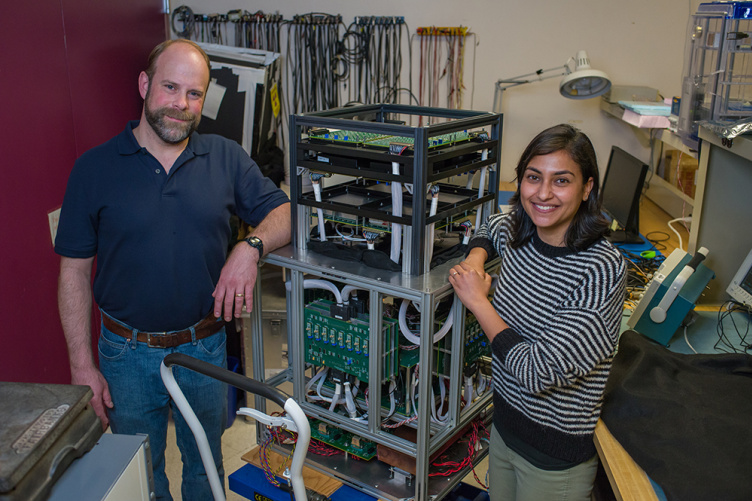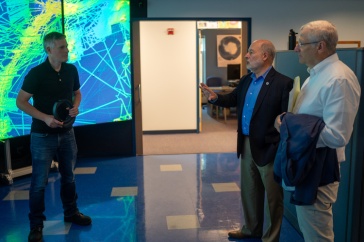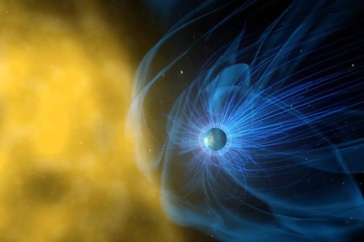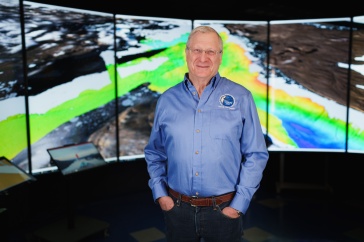
Peter Bloser and Tejaswita Sharma stand beside the telescope they helped to build to detect gamma rays from space.
Scientists are testing a new telescope that detects high-energy light particles streaming through the galaxy to pinpoint the origins of those particles, including supernovas, black holes or other space phenomena.
The telescope was designed and built by a team of 10 researchers and engineers at the University of New Hampshire, some of whom recently traveled to NASA’s Columbia Scientific Balloon Facility in Palestine, Texas, to test the telescope’s ability to detect space-generated gamma rays from 120,000 feet in the air using a large scientific balloon.
The balloon launch — a culmination of three years’ worth of efforts by the team to prepare the instrument for flight — allows researchers to test proof of concept and fine-tune the equipment for a potential future launch into orbit on a satellite. The team was led by Peter Bloser, UNH research associate professor of physics, and Tejaswita Sharma, a Ph.D. candidate at the UNH Space Science Center.
“The goal of the project is to improve the sensitivity of the instruments that were previously built,” Sharma explains in reference to UNH-built gamma ray instruments.
Gamma rays are high-energy photons, or particles of light, that are produced during lightning storms, supernova explosions, and are often found near black holes. Gamma radiation can be harmful to humans, but luckily for us the Earth’s atmosphere blocks the most damaging rays coming to our planet from outer space. Scientists are studying these energetic particles to get a better sense of what’s happening in the far distant regions of our galaxy.
That’s where the new UNH telescope comes into play — it’s dubbed ASCOT, which stands for Advanced Scintillator Compton Telescope. A scintillator detects charged particles produced by gamma ray interactions, and this version is faster, more compact, rugged and less expensive than previous versions built at UNH. Perhaps the most unique aspect of ASCOT is that it utilizes light-sensing technology developed not for astronomy, but instead for medical imaging. Positron emission tomography (PET) scans are used to detect certain diseases in the human body by measuring photons from ingested radioactive material, and as it turns out, detectors built for this measurement come in handy when dealing with particles like gamma rays.
The sources for space gamma rays are notoriously difficult to pinpoint, as the particles either pass right through most types of detectors or they hit electrons in the detectors and scatter like billiard balls on a pool table (a process known as Compton scattering). Scientists then have to reconstruct the potential pathways to determine where the gamma rays may have originated. This ASCOT flight focused on a known source of gamma rays — the Crab Nebula, where the remnants of a supernova from the constellation of Taurus provide the brightest source of gamma rays in our galaxy — in order to then demonstrate that the photon scatters can be reconstructed as expected. Once that calculation is verified, it can be applied to other detections of gamma rays to figure out where they’re coming from and learn more about high-energy physical processes in our universe.
Inspired by Nature
Mechanical engineering professor Yaning Li looks to nature’s shapes and structures to create innovative new materials.
So after a couple of weeks of transporting, reassembling and testing the equipment, the UNH team was finally ready to fly ASCOT. The balloon launch itself was not without its challenges, though; multiple weather delays and some last-minute technological snafus caused weeks of headaches for the team, but eventually they were cleared for takeoff. After two hours of slowly increasing in altitude, the telescope and balloon made it up to 123,000 ft. and stayed afloat for about five hours. It landed safely a few hundred miles to the west of Palestine, where the team retrieved the equipment and downloaded the data for later analysis.
The next step of the process will be for Sharma to dig through the data to determine just how sensitive ASCOT technology really is. Once she works through that portion of the project, the team can make a decision about whether anything needs to be changed to move forward and construct a space-worthy version of the same technology.
Sharma says it’s been a great experience all around, from building the equipment to testing it and then to see it finally launch after years of preparation. “It was almost too good to be true to see the telescope launch with the balloon,” she says. “It took some time to sink in that it was actually going up, especially after all the delays. I’m so glad it worked out.”
Funding for this research is provided by NASA's Astrophysics Research and Analysis Program.
-
Written By:
Rebecca Irelan | Institute for the Study of Earth, Oceans, and Space | rebecca.irelan@unh.edu | 603-862-0990



















































